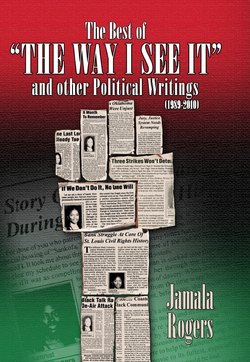Читать книгу The Best of "The Way I See It" and Other Political Writings (1989-2010) - Jamala Rogers - Страница 23
На сайте Литреса книга снята с продажи.
Hair Me Out
ОглавлениеFebruary, 2003
Some years ago, I was commissioned to write an article in defense of black hair, when the now-defunct Trans World Airlines (TWA) was hassling African American women about wearing cornrows. Cornrows, whose origin dates back to ancient Mother Africa, are thin rows of braids woven into intricate patterns and designs. Sometimes they are mistakenly referred to as French braids but French women stole the idea from Africa during the colonial period. This, and more, is what I discovered when I began the research for the article. The research also affirmed for me the important role of hair for black women all over the world and its impact on our notion of beauty. African women do more with their hair and heads than women of any other culture. We have historically put beads, jewels and other forms of adornment in our hair. And yes, even sometimes color from berries or clay has been added to enhance the beauty of a black woman’s hair. Since our capture and transport to the North America shores, our obsession with hair didn’t stop, but it was sure affected by European standards of beauty, from straightening to hair color. Sadly enough, nappy hair is now almost a fad.
A fad implies consumer manipulation for profit and big business it is. African-Americans spend 50-60% more on hair products than white consumers. Black women alone spend over a billion dollars annually on hair. Madam C.J. Walker became the first black, female millionaire from the straightening of nappy hair. Move over, Sister Walker. White manufacturers like Alberto-Culver and Revlon have gotten control of more than half the market for black hair care products. If L’Oreal is successful in acquiring the makers of Dark and Lover, they will dominate 2/3 of the market share of black hair color products. Koreans didn’t sit around watching the dollars pass them by. They now own 60% of all the beauty supply stores in this country, most of which were black-owned at one time. How black folks let the lucrative hair care industry slip from their fingers is the subject of another column.
Jamala has worn the natural look from Afros to cornrows
to dreadlocks. Clockwise: Jamala during her college years
(1969), then much later (2008). Here David Kaczynski and
Jamala share concerns about the death penalty on his visit to
St. Louis. At the time, they both headed up local chapters of the
National Coalition to Abolish the Death Penalty. (2002)
It has been about eighteen months since I cut my dreadlocks. In some ways, the reaction to the cut was as dramatic as when I started the locks fifteen years ago. I thought I was going to have to give some folks CPR. For many, the change was so radical they didn’t even recognize me - including my own mama! While I have worn various forms of natural hair for the past thirty five years, it was the locks that got to enjoy the most years on my head. Partly because of the resistance by the backward St. Louis culture, I was determined not to let anybody, whether they were black or white, dis nappy hair or discriminate against it. That took much longer than I thought. But the bigger reason for keeping them for so long was the fascination I developed in watching them grow. Each lock had its own personality, its own shape and length. I’m sure other “dreads” can attest to this.
Black people - sisters and brothers - do take their hair seriously. That is part of our African culture and history. What we need to take more seriously is reclaiming the market. I can think of a lot of things we can do with a billion- plus dollars in our communities.
